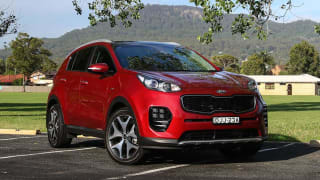
Kia Sportage GT Line diesel 2017 review
Tim Robson road tests and reviews the Kia Sportage GT Line diesel SUV, with specs, fuel consumption and verdict.
Browse over 9,000 car reviews
Tim Robson road tests and reviews the 2017 Mitsubishi ASX XLS AWD diesel with specs, fuel consumption and verdict.
If there was a car company that's stood by the old adage of sticking with a winning formula, it’s Mitsubishi.
MORE: Read the full Mitsubishi ASX 2017 review

Several cars in its current fleet are prolonging their runs long beyond what’s considered a regular shelf life, and the small ASX SUV is one of them.
Introduced in 2010, the five seat, four-door ASX is into its seventh year on sale – and that’s a long time in car years. It’s been tweaked and tuned up over the years, and Mitsubishi has given it a light tweak for 2017… but is it enough?
The all-wheel-drive XLS tops the four-car ASX range, and is priced at $37,000. Powered by a 2.2-litre four-cylinder turbocharged diesel, it’s backed by a continuously variable transmission.
For 2017, it’s scored a mild update to the front end – and the loss of its LED daytime running lamps, oddly enough – as well as minor switchgear revisions in the cabin.
Spec-wise, it’s pretty well laden, with smart keyless entry and pushbutton start, auto lights and wipers, a 7.0-inch colour multimedia screen with satellite navigation, Bluetooth and iPod connectivity (but no Apple CarPlay or Android Auto) and a panoramic roof.
It’s frankly astonishing how much better the XLS is than the base LS ASX.
The multimedia system still actually accepts CDs, and is hooked up to a six-speaker sound system.
It also gets steering wheel-mounted audio and phone controls, leather seat facings, rear view camera and sensors, heated front seats and electrochromatic rear view mirror.
It misses out on modern electronic aids like radar cruise, AEB, rear cross traffic alert and the like, though.
It comes with 18-inch rims as standard, along with a space saver spare wheel.
The ASX was one of the earliest small to mid-sized SUVs to hit the Australian market at the start of the present SUV boom, and while its basic shape and size was novel and interesting when it launched, a myriad of updates and facelifts haven't really done it any favours in the long run.
It’s ended up with a front end design that looks overly busy and not in keeping with the rest of the car’s rather plain lines, thanks mainly to a corporate insistence on adding the brand’s so-called 'Dynamic Shield' grille and front bar.
It's basically unassuming, and it’s not a patch on more modern designs like the Mazda CX-3 and Honda HR-V. Still, the fact it isn’t all creased lines and a tiny cabin is a plus for many.
When it comes to the interior, the leather-faced seats and a minimum of garnish and fuss works in the ASX’s favour; it’s simple and easy to operate. The touchscreen interface is, despite some updates for 2017, getting on a bit, and isn’t the simplest system to operate.
The colour palette includes solid white, 'Starlight Silver', 'Cool Silver', red, 'Lightning Blue', 'Titanium Grey' and black.
The top-spec car is much better equipped than others in the range, with satellite navigation as standard, along with leather trim, heated front seats and a powered driver’s pew.
There is very little in the way of features for rear seaters, with under-front seat vents and no power points. There’s sufficient headroom back there, though, despite the presence of the sunroof, and knee and toe room are good behind an average-sized driver, even for taller passengers.
There are no bottle holders in the doors for rear seaters, but there are cupholders in the centre arm rest. Front seaters get two cupholders and bottle holders capably of holding 1.5-litre beverages. The front centre armrest bin lid is padded and slides for ease of use, too.
There’s a fair bit of glare off the hard plastic dash, though, which can get annoying on a bright day.
Its 393 litres of boot space is around 130 litres larger than the smaller CX-3, while the rear extends to 1193 litres of luggage capacity when the seats are down.
Storage in the front is adequate, with a mobile phone holder hidden under the dash. There are three cupholders in the front, small bottle-holders in each of the four doors, and two cupholders in the centre of the rear seats.
In a bonus for the ASX, the rear seat is big enough for three teenage kids, and there is adequate headroom even for taller passengers. Two ISOFIX baby car seat mounts are included.
The XLS’s driver's seat is good, though the short squab can dig into the driver's thighs on longer trips.
One irritation; when the rear seats are folded down, the seat belts remain in place, which takes away some of the usable load area’s dimensions.
The 7.0-inch colour touchscreen-based multimedia system sports digital radio, which is a nice addition, but the iPod connection is little more than a line-in device that offers limited functionality when compared to Apple CarPlay.
Mitsubishi added the 2.2-litre four-cylinder turbo-diesel from the larger Outlander to the ASX in 2012, along with a traditional six-speed automatic transmission.
Engine specs of the direct injection common rail oiler are rated at 110kW of power, along with 360Nm of torque from a low 1500rpm.
It’s smooth, quiet and almost rattle free, and the electronic 'MIVEC' all-wheel drive (AWD) system – for which Mitsubishi is quite famous – behaves very well in the city.
Mitsubishi rates the ASX LS at 6.0L/100km on the combined fuel economy cycle, while we recorded mileage of 7.2L/100km after 300km via the dash.
Its 60-litre tank gives it a theoretical range of 1000km.
The top-shelf AWD ASX is a notably better drive than the base model, with more linear (but still numb) steering feel, a more planted and settled ride, and a quiet, unfussed demeanor.
Larger rims with lower profile tyres help a lot here, too, by stiffening up the suspension and giving the ASX a better footprint on the road.
The 'DID' diesel is a real sweetie, too, with minimal noise encroaching into the cabin. There is the merest hint of diesel rattle when the throttle is loaded up, but it’s distant and muted.
The regular auto works well too, selecting gears smoothly and intuitively.
The ASX is not built to tackle full-on 4x4 trails, but it will traverse off road terrain like fire trails and moderately difficult sandy tracks relatively easily. A ‘4WD’ button on the centre console engages all four wheels quickly and simply, and there’s even a button to lock the ASX into 4x4 mode if the going gets a bit slippery.
A word of warning – don’t drive with the lock mode engaged on the road, or you’ll be facing higher repair bills a lot sooner, as the added drag and grip on the driveline wears joints and bearings much faster.
The ground clearance of the AWD XLS is actually slightly lower than that of the FWD ASX at 180mm (versus 205mm), thanks to the AWD gear hanging under the car.
Towing capacity is 1400kg for a braked trailer, which covers light vans and camper trailers, as well as smaller boats.
The age of the ASX means it doesn’t – and won’t ever – have any modern electronic safety aids like AEB or radar cruise control. It does have emergency brake assist, however, and seven airbags.
It’s rated at a maximum five from five stars on the ANCAP safety scale.
Mitsubishi offers a five-year, unlimited kilometre warranty, four years of free roadside assistance and a three-year capped price service program for the ASX.
Due at every 15,000km or 12 months, each service costs $350, $500 and $630 respectively.
The servicing arrangement will expire if the car travels more than 52,500km within the three-year period, though.
The ASX enjoys a reputation for being a low-maintenance, worry-free car, with little history of recalls or problems to report.
It’s frankly astonishing how much better the XLS is than the base LS ASX. It’s a $10,000 leap in price, sure, and the diesel is dearer to own, but once you compare the pair on the road, there’s absolutely no contest.
The ASX gives away ground to rivals like the diesel powered Kia Sportage/Hyundai Tucson pair – mostly by virtue of age – but if a small Mitsubishi SUV is dear to your heart, then spending the extra on the top spec XLS is highly recommended.
| Vehicle | Specs | Price* | |
|---|---|---|---|
| LS (4WD) | 2.3L, Diesel, 6 SP AUTO | $20,570 – 26,070 | 2017 Mitsubishi ASX 2017 LS (4WD) Pricing and Specs |
| LS (2WD) | 2.0L, ULP, 5 SP MAN | $17,710 – 22,440 | 2017 Mitsubishi ASX 2017 LS (2WD) Pricing and Specs |
| XLS (4WD) | 2.3L, Diesel, 6 SP AUTO | $23,210 – 28,710 | 2017 Mitsubishi ASX 2017 XLS (4WD) Pricing and Specs |
| XLS (2WD) | 2.0L, ULP, CVT AUTO | $21,120 – 26,730 | 2017 Mitsubishi ASX 2017 XLS (2WD) Pricing and Specs |
$12,990
Lowest price, based on 248 car listings in the last 6 months